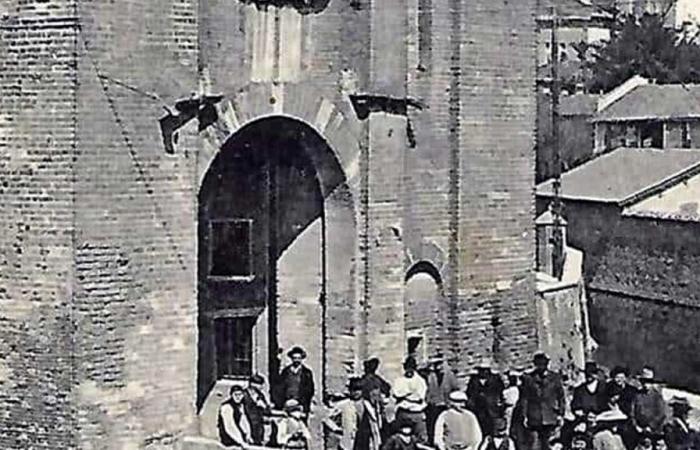It was 1989 when, following the demolition of the ancient Porta de’ Gradi in 1908, in Monza people were once again talking about Borgo Bergamo, the neighborhood that developed around the street of the same name, today the “kingdom” of young people but which time known as the suburbs inhabited by the “evil people”.
The story of the ancient village is clarified by the lady of Monza Ghi Meregalli, creator of the famous historical parade of June in Monza, who explains how the history of Borgo Bergamo has always been linked to that of the Visconti walls and that of the famous Porta di San Giacomo. “It was the merchants of the time who asked me to give the street an identity again – she said – So I decided to roll up my sleeves. First of all by giving a name to the courtyards of the area, as it was originally, and then by reproducing the ‘quadrell del borg’, the tile on which the logo of the ancient Borgo Bergamo was engraved and which was part of the destroyed Porta de’ Gradi”.
It is precisely from the Porta de’ Gradi, in fact, that the events of that somewhat special suburb unfold, today one of the most innovative neighborhoods of the city. As also explained by local history enthusiast Ettore Radice, the Porta de’ Gradi was the last testimony of the city walls built by Azzone Visconti in 1333 and demolished in 1908 because the bridge that allowed access, suspended over the Lambro, in today’s Via Azzone Visconti, was too narrow and steep to allow carts to pass. Especially those of fruit and vegetable merchants who, coming from out of town, were interested in selling their products in the city market.
The medallion with the effigy of the saint
“The Porta de Gradi was so called because it was located on the path that led to Agrate and Brianza in general, dividing the village of Via Bergamo from the rest of the city – Meregalli continues – Overlooking it is a large marble medallion with the effigy of Saint Giacomo, patron saint of hatters, placed there in 1704 by Count Giacomo Durini, progenitor of the lineage of bankers who had purchased the fiefdom of Monza from the De Leyvas, the important Spanish family that boasted among its descendants Sister Virginia, the famous nun of Monza The hatters’ festival was celebrated every year on July 25th, and then the area around the bridge became a sort of dance hall where people danced and drank for a whole day and night. Once it was even thought of temporarily covering the bed del Lambro with wooden boards, so that there was more space to dance”.
Having decided to demolish the gate, at the behest of the municipal administration, it was decided to save the medallion. Which in fact was placed on the external wall of the sacristy of the church of Saints Giacomo and Donato in via Buonarroti, in the San Donato district, where the ancient residence of the Durini family still exists today and where it was jealously guarded by the faithful of the neighborhood. From there, on the occasion of the redevelopment of via Bergamo, in 2010, thanks to a proposal put forward by Meregalli herself, by Radice and other supporters, the surviving medallion was mounted on a metal structure and placed in via Pesa del Lino. Where it is still visible today. Precisely in memory of the ancient gate through which thousands of people, from the Middle Ages to the dawn of the 20th century, entered the city.
The cult of Saint James
To the patron saint of hatters and martyr bishop of Arezzo, Donato, the church on via Buonarroti in the San Donato district was consecrated on the night of 21 October 1937 by Cardinal Ildefonso Schuster of Milan. Before then, the entire parish had always been under the jurisdiction of the church of San Gerardo, and the faithful would go to pray in the small temple dedicated to San Giacomo and incorporated into an ancient court house in nearby via Cimabue. Once the mansion of the illustrious Count Durini, it is still recognisable by the small fresco depicting the saint on the perimeter wall and visible from the street, retouched in the last century by the painter from Monza Fiorentino Vilasco, who lived in via Buonarroti and is known throughout Brianza.
However, once the new church was opened, worship at the small temple has never waned, and even today on 25 July, the day that the church dedicates to the memory of the saint, the faithful gather to pray and celebrate under the painting. As has always been the custom among the city’s hatters, who did not miss the meeting even in ’45.
With the redevelopment of Via Bergamo, the fate of the effigy of San Giacomo, the three meter high marble medallion placed on the Porta de’ Gradi, has changed. It was in fact taken from the suburban church and relocated to its original position. There where one of the four access gates to the city built by Azzone Visconti stood. But the faithful of Via Buonarroti would never have been without their saint. And so we thought of a resin cast of the statue, which replaced the previous one in front of the kindergarten entrance. In memory of that cult for the pilgrim apostle which, after many centuries, has never been forgotten.
The Punt de la Mariotta the “evil people”
“The ancient inhabitants of Via Bergamo were known as the ‘evil people’ – Meregalli continued – They were very poor people, who lived by their wits, and many women used to prostitute themselves to support their families. The chronicles instead recall how the men used to steal bicycles and hide them in the Lambro to then fish them out. A ploy that allowed them to justify themselves to the police, to whom they told that they had found them in the water by chance. During the war, attacks on German trucks had also become common. As soon as they entered the street, there was always someone ready to lower himself from a window on the first floor of a building and, once he had climbed onto the roof of the vehicle, he would throw the supplies onto the street so that his accomplices could collect them”.
No less famous were the old merchants of the Borgo, to whom the various courts were later dedicated. Like the “cort de la sciura” in via Pesa del Lino, so called because a rather humble woman lived there but who also acted like a great lady, or the “cort de mazzacavaj”, the courtyard in which the first meat shop of the illustrious Fossati family, future owners of the famous “Simmenthal”, opened. After slaughtering the horses, they resold their meat, along with the luganega.
“The best-known activity at the beginning of the 20th century was undoubtedly the one known as the ‘Punt de la Mariotta’ – concluded Meregalli – It was the house – shop of a greengrocer, Mariotta precisely, at the entrance to the Ponte de’ Degrees”.






